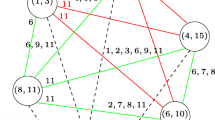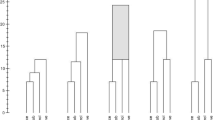Abstract
A method is developed which for a given objects by variables data matrix estimates weighted inter-object distances that are optimally suited for either an ultrametric or an additive tree representation. The effectiveness of the method is demonstrated on two synthetic data sets having a known tree structure and on one real data set. In the final section, some possible extensions of the present method are discussed.
Similar content being viewed by others
References
Anderberg, M.R. (1973). Cluster analysis for applications. New York: Academic Press.
Art, D., Gnanadesikan, R. and Kettenring, J.R. (1982). Databased metrics for cluster analysis, Utilitas Mathematica 21A: 75–99.
Carroll, J.D. (1976). Spatial, non-spatial and hybrid models for scaling, Psychometrika 41: 439–463.
Carroll, J.D. and Pruzansky, S. (1980). Discrete and hybrid scaling models, pp. 108–139 in E.D. Lantermann and H. Feger, eds., Similarity and choice. Bern: Huber.
Cunningham, J.P. (1978). Free trees and bidirectional trees as representations of psychological distance, Journal of Mathematical Psychology 17: 165–188.
De Soete, G. (1983). A least squares algorithm for fitting additive trees to proximity data, Psychometrika 48: 621–626.
De Soete, G. (1984) A least squares algorithm for fitting an ultrametric to a dissimilarity matrix, Pattern Recognition Letters 2: 133–137.
De Soete, G., DeSarbo, W.S., Furnas, G.W. and Carroll, J.D. (1984a). Tree representations of rectangular proximity matrices, pp. 377–392 in E. Degreef and J.van Buggenhaut, eds., Trends in mathematical psychology. Amsterdam: North-Holland.
De Soete, G., DeSarbo, W.S., Furnas, G.W., and Carroll, J.D. (1984b). The estimation of ultrametric and path length trees from rectangular proximity data, Psychometrika 49: 289–310.
Dobson, A.J. (1974). Unrooted trees for numerical taxonomy, Journal of Applied Probability 11: 32–42.
Fowlkes, E.B. (1981), Stepwise variable selection methods for hierarchical clustering, Seminar held at Bell Laboratories, Murray Hill, N.J.
Gill, P.E., Murray, W. and Wright, M.H. (1981). Practical optimization. London: Academic Press.
Hartigan, J.A. (1975). Clustering algorithms. New York: Wiley.
Hauber, A.R. and van Winzum, C.C. (1983). Gedragstherapie bij deliquenten: Een verkennend onderzoek bij Nederlandse gedragstherapeuten, Gedragstherapie 16: 219–236.
Johnson, S.C. (1967). Hierarchical clustering schemes, Psychometrika 32: 241–254.
Milligan, G.W. (1980). An examination of the effect of six types of error perturbation on fifteen clustering algorithms, Psychometrika 45: 325–342.
Powell, M.J.D. (1977). Restart procedures for the conjugate gradient method, Mathematical Programming 12: 241–254.
Rohlf, F.J. (1970), Adaptive hierarchical clustering schemes, Systematic Zoology 19: 58–82.
Sattath, S. and Tversky, A. (1977). Additive similarity trees. Psychometrika 42: 319–345.
Sneath, P.H., & Sokal, R.R. (1973). Numerical Taxonomy. San Francisco: Freeman.
Author information
Authors and Affiliations
Rights and permissions
About this article
Cite this article
De Soete, G. Optimal variable weighting for ultrametric and additive tree clustering. Qual Quant 20, 169–180 (1986). https://doi.org/10.1007/BF00227423
Issue Date:
DOI: https://doi.org/10.1007/BF00227423




